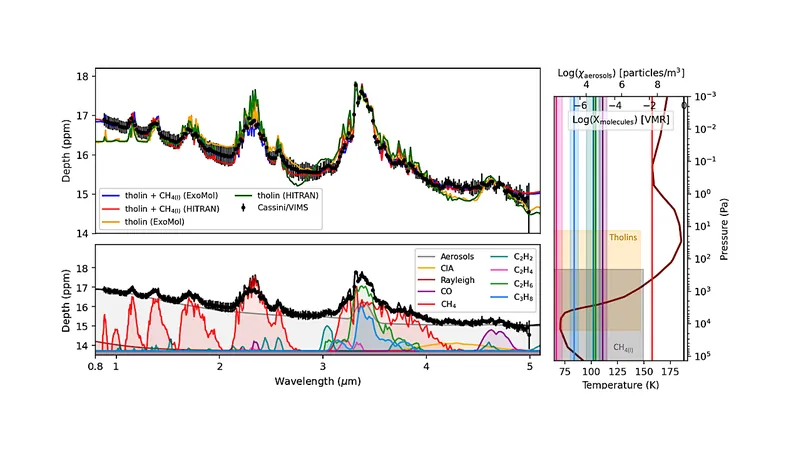
Dramatic Satellite Descent Sparks Atmospheric Pollution Insights!
2025-05-08
Author: Mei
The Fiery Fall of Cluster Salsa
In an audacious scientific endeavor, researchers are leveraging the breathtaking sight of a satellite's fiery descent to gather vital data on atmospheric pollution caused by spacecraft reentries. In September 2024, a dedicated team of European scientists embarked on a nighttime mission, armed with 26 cameras, to record the dramatic fall of the Cluster Salsa satellite as it plummeted through the skies above the Pacific Ocean. Launched from Easter Island, this mission aimed to capture the chemical byproducts released during the satellite’s swift, meteor-like reentry.
Unveiling the Environmental Risks of Reentries
A stunning report unveiled at the European Conference on Space Debris brought to light the potential environmental fallout from such reentries. The fiery reentry of Cluster Salsa generated harmful emissions of lithium, potassium, and aluminum—elements known to threaten the precious ozone layer and exacerbate climate change. Stefan Löhle from the University of Stuttgart commented on the satellite's faint trail, which indicated that the fragments broke apart with less intensity than experts had predicted. Observations revealed that disintegration began at around 80 kilometers above sea level, with crucial data collection ending at about 40 kilometers due to visibility challenges.
The Growing Importance of Monitoring Satellite Reentries
With satellite reentries becoming increasingly frequent, monitoring these events is crucial. While spacecraft, like SpaceX's Starlink satellites, are engineered to disintegrate entirely upon reentry, lingering debris and dust particles may still affect the upper atmosphere. For instance, aluminum oxide released from melting satellites could contribute to long-term changes in atmospheric chemistry, impacting thermal balance and ozone levels.
A Pioneering Mission in Atmospheric Research
This remarkable mission marks just the fifth time researchers have observed a spacecraft reentry from the air. By correlating their observations with computer models, scientists aim to assess the mass lost during disintegration and its interactions with the atmosphere. Preliminary findings suggest that some titanium parts from the 550-kilogram Cluster Salsa might have survived the plunge and landed in the Pacific Ocean.
What’s Next? Future Observations Await!
As satellite reentries soar, researchers are gearing up to apply this observational approach to Cluster Salsa’s sister satellites—Rumba, Tango, and Samba—set for reentry by 2026. Although daylight conditions may hinder some measurements, these future missions promise to deepen our understanding of how satellite pollution impacts Earth's upper atmosphere and climate.
Charting New Frontiers in Environmental Research
The insights gathered from the Cluster Salsa mission will be pivotal in advancing studies on atmospheric pollution caused by spacecraft. By aligning their findings with existing computer models, scientists aspire to unravel the mysteries surrounding the mass lost during reentries and their subsequent chemical interactions with the atmosphere. This knowledge is vital as the number of satellites continues to surge, highlighting the urgent need for understanding their environmental implications.
As researchers prepare for more ambitious missions, their focus remains on uncovering the environmental repercussions of spacecraft reentries. The insights from these studies could shape policies and practices aimed at mitigating the ecological impacts of space debris, ensuring a sustainable future for both our planet and the cosmos.


 Brasil (PT)
Brasil (PT)
 Canada (EN)
Canada (EN)
 Chile (ES)
Chile (ES)
 Česko (CS)
Česko (CS)
 대한민국 (KO)
대한민국 (KO)
 España (ES)
España (ES)
 France (FR)
France (FR)
 Hong Kong (EN)
Hong Kong (EN)
 Italia (IT)
Italia (IT)
 日本 (JA)
日本 (JA)
 Magyarország (HU)
Magyarország (HU)
 Norge (NO)
Norge (NO)
 Polska (PL)
Polska (PL)
 Schweiz (DE)
Schweiz (DE)
 Singapore (EN)
Singapore (EN)
 Sverige (SV)
Sverige (SV)
 Suomi (FI)
Suomi (FI)
 Türkiye (TR)
Türkiye (TR)
 الإمارات العربية المتحدة (AR)
الإمارات العربية المتحدة (AR)